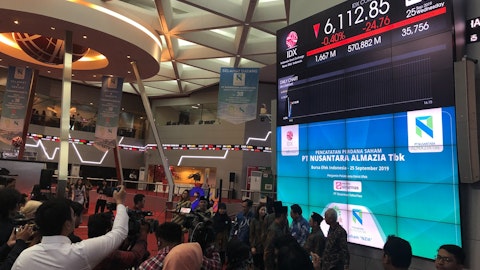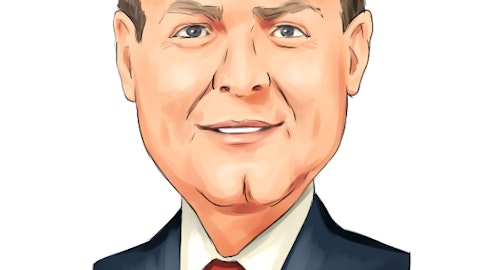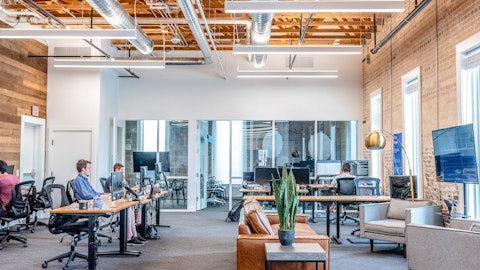So that if you’re an HVAC operator as an example and you are out on a job, you can book the appointment in the system. The system reminds the homeowner of the appointment ahead of time, and dispatches the HVAC to address on the day of, the HVAC shows up at the address, and can present a mobile proposal with real-time inventory and pricing information. They can then get if they’d say — the homeowner accept proposals, they can schedule and manage within the system. So if you can just envision a very integrated experience within the workflow of the customer. And as Jagtar said, we’ve got 150,000 customers within our fleet portfolio that — within field services management. And so what we’re really focused on is how we can take the relationships we have, the knowledge that we have and what customer need is, and then create an even better customer experience with our products.
Payzer itself is growing 30%. Just again, a little bit more context, it’s $25 million to $30 million of revenue and growing at 30%.
Robert Napoli: Great. My follow-up question on just the TAM of EV $1.5 billion to $2 billion. And obviously, you have your venture fund, you’ve made an investment or 2 there. But just your thoughts on attacking that? I know you’re going to have a charge-at-home product. I think the EV payments market is a lot more complicated than people understand. And just maybe your thoughts around the TAM of EV, how you attack it and any update on what you’re seeing?
Melissa Smith: Yes, in the TAM we estimated just based on the existing initial product offerings that are needed within the marketplace. So we’ve talked about being very focused around an integrated experience with our customers so that if they’re buying en route, if they’re buying at home or if they’re buying at a depot that we have an integrated offering with their ICE vehicles. And that’s been really the very much the focus that we’ve had. We’ve rolled out the en route charging. We talked about at home charging that we’re in a test stage and anticipating rolling that out into full production by the end of the year here in the United States. And then depot charging in the beginning of next year. We also added in functionality on our app, which is called DriverDash, which allows an integrated offering of purchasing, which simplifies the way that fleets are able to actually purchase using historically some of these multiple fobs.
And so when we look at our opportunity, and you pointed it out, there’s a lot of complexity. We have an opportunity to remove that. For charging fees associated with that, they’re subscription-based fees. And we are in that range of $5 to $20 per month per vehicle that we talked about in Investor Day. And so we feel like we’ve got this great opportunity to introduce new products and really meeting our customers with where they’re at and what they need and also change the revenue dynamics of the company into more and more subscription or SaaS-based fees, which are so far playing out to be very true in what we’ve seen in the marketplace. So we’re really excited about this. We think this could be another opportunity we talk about the way to increase the growth profile of our Mobility business.
Operator: Your next question comes from the line of Ramsey El-Assal.
Ramsey El-Assal: I wanted to ask, Melissa, about your comments about the travel volumes outpacing OTA and the sort of shift in the market to settle with the virtual cards. Can you talk about what’s driving that shift and how sustainable you think it will prove to be?
Melissa Smith: Yes. When — earlier, when we were coming out of the pandemic, a lot of volume, we would have attributed to the fact that you’re seeing this rebound. But clearly, we’re beyond that point in time. We’re 154% of volume from 2019. And you can see the trends that we have are really positive here across all regions. We believe that what we’re experiencing is in part because of the fact that we’re working actively with our customers to make sure that we’re providing offerings that are relevant to them. We also believe that we’re benefiting from this shift to the merchant model, particularly in Europe as online travel agencies have migrated from the agency model to the merchant model, where we’re more relevant. And so we’re capturing more of a benefit associated with that.
And that’s going to play over some time, that’s not done yet. So we think in the — kind of in the midterm that you will continue to see the benefit of those things. We’re also probably seeing some rebound, particularly in the beginning of this year. So we’d expect the rate would go down from this year’s rate of growth. But we do think that we’re going to continue to outpace the market growth.
Ramsey El-Assal: Okay. And one follow-up from me. I wanted to ask again about Payzer and just to make sure I’m understanding it correctly. Is Payzer a way that you kind of deepen engagement and/or monetize existing customers? Or is it also a customer acquisition channels for your products like you — just Payzer bringing you customers that maybe then you — become fuel card customers or I guess that’s one part of the question. The other one is there a broader opportunity to kind of verticalize your business?
Melissa Smith: Yes. Great question. So Payzer itself, on a stand-alone basis is growing 30%. So they’re doing a great job with customer acquisition kind of [indiscernible] stop. And so when we looked at our model of the acquisition, it was with the idea that the asset that we’re acquiring is already growing at that rate. We think that we can supplement that growth through exposure to our existing customers that are in their verticals that they’re paying attention to. And so it is — the intention is to continue to have them sell — to sell independently and then also expose our customers into their sales solutions. So they have an opportunity to increase the growth profile of the business, less about us selling into their customers, at least initially, just because our customer segment size is just much bigger than theirs. Over time, maybe that would happen.
Operator: Your next question comes from the line of Mihir Bhatia.
Mihir Bhatia: I wanted to ask about the Benefits side. Any comments just on early sign-up season, on what you’re seeing? It sounds like you had a nice win in the segment with the energy company. But I was just more curious about just generally the drivers of growth in that segment also. Is it more employees signing up for HSAs? Is it mostly client wins and bringing more clients onto the platform? What’s the main driver of growth there? And with some forecast calling for a little bit of an uptick in unemployment next year. Is that something that could maybe be a bit of a headwind you have to grow through next year?
Melissa Smith: All right. So I’m going to — I’ll hit a bunch of questions I think embedded in there. The growth along — the growth of the segment, we said is 15% to 20%. And clearly, we’re way above that this year. Some of that we’re benefiting because of interest rate increases. But we do — in our 15% to 20% growth we’re assuming that you’re going to see custodial assets that will outpace the of the accounts, and so we’re going to get some benefits from that. So if you go through the primary drivers for us, first is the addition of accounts, which comes through supporting our partners for them to grow and grow indirectly in the marketplace. Historically, there’s also more assets per account. The growth over time because those accounts filled so we should get some leverage on the fact that the account size gets bigger and so we get custodial revenues associated with that.





